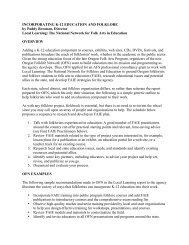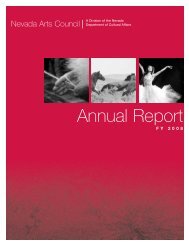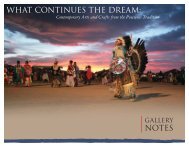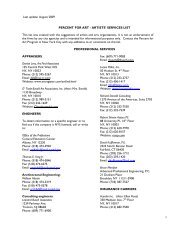Handed Down - Nevada Arts Council
Handed Down - Nevada Arts Council
Handed Down - Nevada Arts Council
Create successful ePaper yourself
Turn your PDF publications into a flip-book with our unique Google optimized e-Paper software.
1990–1991<br />
Paiute Buckskin Smoking:<br />
Norma Williams and Stacy Gibbs<br />
Norma Williams grew up with willow cradleboards<br />
and baskets, buckskin moccasins and dresses, and<br />
decorative beadwork. A Paiute Indian, she was born<br />
at Stillwater, attended the Stewart Indian School, and<br />
moved to Schurz when she married. Of the traditional<br />
crafts of her people she says, “It was part of our everyday<br />
life, you did it because you needed it. I just kept it up<br />
all this time.”<br />
Norma is the only person in Schurz she knows of<br />
who still tans and smokes deer hides the traditional<br />
way, and her granddaughter Stacy Gibbs recalls helping<br />
stretch hides as a child. Stacy learned the skills of scraping<br />
and tanning buckskin, but before the apprenticeship<br />
had never smoked them to give them the traditional<br />
golden color Paiute hides are known for.<br />
The long process of preparing hides starts when a<br />
Paiute hunter skins the animal by pulling the hide off<br />
rather than cutting it. Cutting can make holes or leave<br />
chucks of meat on the hide; “That’ll ruin your hide right<br />
there, if they don’t know how to skin them good,” Stacy<br />
explains. The hide is then soaked in water for up to a<br />
week to loosen the hair, and the hair and thin layer of<br />
skin are scraped off with a drawknife, again taking great<br />
care not to cut holes. The traditional tanning process<br />
involves rubbing the hide with cooked brains to soften<br />
it; after that the hide is stretched constantly until it is<br />
dry, a tiring and time-consuming process that leaves it<br />
soft and white. “If you get it done and you see yellow<br />
streaks or it’s real hard in certain spots, that’s when she<br />
[Norma] gets it and dunks it back in the water, and<br />
that’s when you cry,” Stacy laughs. “But you have to do<br />
it over,” Norma reminds her.<br />
Other tribes use unsmoked white hides, but the Paiutes<br />
are known for their golden smoked buckskin. Two<br />
hides are sewn together along their edges with the scraped<br />
surface inside, and the bottom left open. A strip of canvas<br />
is sewn around the bottom and the hides are hung up<br />
over a can of smoking cedar chips. Any holes where smoke<br />
leaks out are patched or covered with tape and the canvas<br />
is tied tightly around the can to keep the smoke in. After<br />
20 or 30 minutes the hides are checked and if the color is<br />
right they are pulled apart and aired out.<br />
Buckskin is used to make moccasins, gloves, vests,<br />
cradleboard covers and other small items, but Stacy<br />
used the hides she smoked to make a dance dress for<br />
her four-year-old daughter Alyssa. Two hides were<br />
Norma<br />
Williams<br />
shows some<br />
buckskin gloves<br />
and clothing<br />
she’s made.<br />
Norma<br />
Williams<br />
watches as Stacy<br />
Gibbs checks a<br />
freshly smoked<br />
hide for color.<br />
enough for the small dress, but an adult dress can take<br />
up to seven hides. Alyssa dances with the Screaming<br />
Eagle Dancers of Schurz, directed by Stacy’s mother, so<br />
the dress will get plenty of use. When she outgrows it<br />
her little sister will get it, and Alyssa will get the larger<br />
dress her mother used when she was a girl. Not only<br />
will the dresses themselves be passed on, but so too will<br />
the knowledge of how to make them and the meaning<br />
surrounding them.<br />
17
















